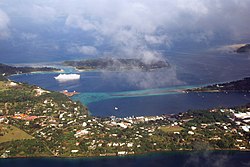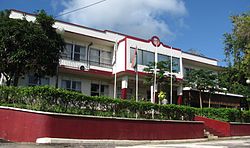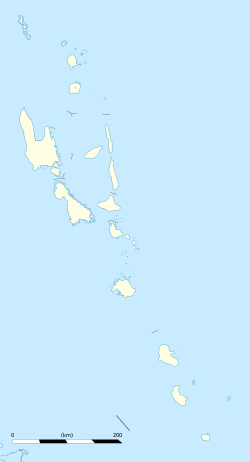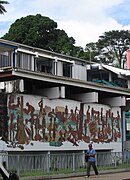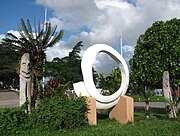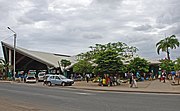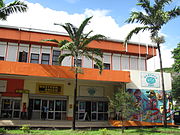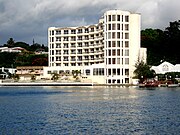-
Presbyterian Church
-
Wall painting opposite the market
-
Vanuatu Parliament
-
Memorial opposite the Parliament building
-
Market hall
-
Market
-
Post office. The building once marked the unofficial demarcation between the two sectors of Port Vila, the British Paddock to the south and the Quartier français to the north
-
The natural harbour as viewed from town looking out at sea with Iririki Island to the left
-
City Hall
-
Grand Hotel and Casino Vanuatu, the tallest building in the country
Port Vila
 From Wikipedia - Reading time: 16 min
From Wikipedia - Reading time: 16 min
This article has multiple issues. Please help improve it or discuss these issues on the talk page. (Learn how and when to remove these messages)
|
Port Vila
Vila | |
|---|---|
City | |
From top: left to right - aerial view of central Port Vila, Parliament building, Port Vila Harbour and Port Vila City Hall. | |
| Coordinates: 17°44′S 168°19′E / 17.733°S 168.317°E | |
| Country | |
| Province | Shefa Province |
| Island | Efate |
| Government | |
| • Mayor | Jenny Regenvanu (GJP) |
| Area | |
• Total | 23.6 km2 (9.1 sq mi) |
| Elevation | 59 m (194 ft) |
| Population (2020)[1] | |
• Total | 49,034 |
| • Density | 2,100/km2 (5,400/sq mi) |
| Time zone | UTC+11 (VUT) |
Port Vila (/ˈviːlə/; French: Port-Vila), or simply Vila ([viˈla]), is the capital and largest city of Vanuatu. It is located on the island of Efate.
The population was 49,034 as of the 2020 census.[2] In 2020, the population of Port Vila formed 16.3% of the country's population.
On the south coast of the island of Efate, in Shefa Province, Port Vila is the economic and commercial centre of Vanuatu. The mayor is Jenny Regenvanu of the Land and Justice Party, the first woman to hold the position, elected in August 2024. Her deputy is Marie Louise Milne, of the Green Confederation.[3]
On 13 March 2015, Port Vila suffered extensive damage from Cyclone Pam.[4]
Name
[edit]Locally the town is most commonly referred to simply as "Vila", whether in French or Bislama [viˈla] or in English /ˈviːlə/ VEE-lə (not like English "villa").[citation needed]
The name of the area is Efil in the native South Efate language and Ifira in neighbouring Mele-Fila language. Vila is a variant of these names. Ifira is a small island in Vila harbour where many of the area's traditional landowners reside.
History
[edit]The area occupied by Port Vila has been inhabited by Melanesian people for thousands of years. In Autumn of 2004, an archaeological expedition known as Teouma discovered a burial site of 25 tombs containing three dozen skeletons of members of the Lapita culture. Pieces of ceramics found at the site were dated to the 13th century BC.
Efate Island was charted in 1774 by James Cook, who named it Sandwich Island. Cook's expedition did not land but noted the presence of good harbours and land suitable for European settlement. In late 19th century when the islands were known as the New Hebrides, the British were initially the dominant European presence, though by the 1890s, the economic balance had begun to favour the French, who established large plantations. French citizen Ferdinand Chevillard began buying and clearing land around Port Vila to be converted into the largest French plantation on the island. Instead, it was converted into the municipality of Franceville, which declared independence on 9 August 1889, though this only lasted until June of the following year.
It was the first self-governing nation to practice universal suffrage without distinction of sex or race. Although the population at the time consisted of about 500 native islanders and fewer than fifty whites, only the latter were permitted to hold office. One of the elected presidents was a US citizen by birth, R. D. Polk, a relative of American president James K. Polk.[5]
After 1887, the territory was jointly administered by the French and the British. This was formalized in 1906 as an Anglo-French Condominium. During World War II, Port Vila was an American and Australian airbase.
In 1987, Cyclone Uma severely damaged the city. A powerful earthquake in January 2002 caused minor damage in the capital and surrounding areas. The city suffered massive damage from a category 5 cyclone named Cyclone Pam in March 2015, whose eye wall passed just to the east of Port Vila.
Geography
[edit]Climate
[edit]Port Vila has a tropical climate, more specifically a tropical rainforest climate, with noticeably wetter and drier months. As the trade winds are almost permanent and cyclones are not rare in Port Vila, the climate is not equatorial but maritime trade-wind tropical climate.[6] Rainfall averages about 2,338.9 millimetres or 92.08 inches per year, and the wettest month is March. The driest month is September. There are 153 wet days in an average year. The area also has south-east trade winds. Temperatures do not vary very much at all throughout the year, and the record high is 35.6 °C or 96.1 °F. The coolest month, July, has an average high of 27 °C or 80.6 °F, and an average low of 18 °C or 64.4 °F. The hottest month, February, has an average high of 31.2 °C or 88.2 °F and an average low of 23 °C or 73.4 °F. The record low for Port Vila is 8.5 °C or 47.3 °F. Humidity is often high.
| Climate data for Port Vila, Vanuatu (Bauerfield International Airport) | |||||||||||||
|---|---|---|---|---|---|---|---|---|---|---|---|---|---|
| Month | Jan | Feb | Mar | Apr | May | Jun | Jul | Aug | Sep | Oct | Nov | Dec | Year |
| Record high °C (°F) | 35.0 (95.0) |
33.9 (93.0) |
33.5 (92.3) |
32.5 (90.5) |
31.1 (88.0) |
32.0 (89.6) |
34.3 (93.7) |
32.0 (89.6) |
31.5 (88.7) |
31.2 (88.2) |
33.0 (91.4) |
35.6 (96.1) |
35.6 (96.1) |
| Mean daily maximum °C (°F) | 31.3 (88.3) |
31.2 (88.2) |
30.8 (87.4) |
29.9 (85.8) |
28.8 (83.8) |
27.4 (81.3) |
26.4 (79.5) |
27.0 (80.6) |
27.7 (81.9) |
28.5 (83.3) |
29.2 (84.6) |
30.7 (87.3) |
29.1 (84.4) |
| Daily mean °C (°F) | 26.4 (79.5) |
26.5 (79.7) |
26.3 (79.3) |
25.3 (77.5) |
24.1 (75.4) |
23.0 (73.4) |
22.1 (71.8) |
22.0 (71.6) |
22.7 (72.9) |
23.4 (74.1) |
24.6 (76.3) |
25.7 (78.3) |
24.3 (75.7) |
| Mean daily minimum °C (°F) | 22.5 (72.5) |
23.0 (73.4) |
22.6 (72.7) |
22.0 (71.6) |
20.2 (68.4) |
19.8 (67.6) |
18.2 (64.8) |
18.0 (64.4) |
18.4 (65.1) |
19.6 (67.3) |
20.7 (69.3) |
21.7 (71.1) |
20.5 (68.9) |
| Record low °C (°F) | 15.8 (60.4) |
15.0 (59.0) |
16.3 (61.3) |
14.5 (58.1) |
13.4 (56.1) |
10.0 (50.0) |
8.5 (47.3) |
10.0 (50.0) |
9.9 (49.8) |
11.0 (51.8) |
12.6 (54.7) |
15.2 (59.4) |
8.5 (47.3) |
| Average rainfall mm (inches) | 316.1 (12.44) |
273.7 (10.78) |
320.9 (12.63) |
255.2 (10.05) |
210.3 (8.28) |
180.0 (7.09) |
94.4 (3.72) |
87.4 (3.44) |
87.3 (3.44) |
134.1 (5.28) |
192.3 (7.57) |
187.2 (7.37) |
2,338.9 (92.09) |
| Average rainy days (≥ 1.0 mm) | 15.4 | 16.6 | 18.5 | 17.1 | 12.9 | 11.3 | 10.3 | 9.8 | 8.1 | 8.4 | 12.1 | 13.2 | 153.7 |
| Average relative humidity (%) | 84 | 85 | 86 | 87 | 85 | 85 | 83 | 82 | 80 | 81 | 82 | 83 | 84 |
| Average dew point °C (°F) | 24 (75) |
24 (75) |
24 (75) |
23 (73) |
21 (70) |
21 (70) |
20 (68) |
20 (68) |
20 (68) |
21 (70) |
22 (72) |
23 (73) |
22 (71) |
| Mean monthly sunshine hours | 220.1 | 155.4 | 198.4 | 165.0 | 170.5 | 162.0 | 148.8 | 167.4 | 174.0 | 198.4 | 180.0 | 195.3 | 2,135.3 |
| Mean daily sunshine hours | 7.1 | 5.5 | 6.4 | 5.5 | 5.5 | 5.4 | 4.8 | 5.4 | 5.8 | 6.4 | 6.0 | 6.3 | 5.8 |
| Source 1: Deutscher Wetterdienst[7] | |||||||||||||
| Source 2: Time and Date (dewpoints, between 2005-2015)[8] | |||||||||||||
Economy and transport
[edit]Port Vila is Vanuatu's most important harbour and the center of the country's trade. The international airport, Bauerfield International (VLI) is also located in the city. Air Vanuatu has its head office in Vanuatu House in Port Vila.[9]
Major industries in the city remain agriculture and fishing. Tourism is also becoming important, especially from Australia and New Zealand. There were over 80,000 visitors in 1997.[10]
Vanuatu is a tax haven, and offshore financing in Port Vila is an important part of the economy.
Vanuatu is still dependent on foreign aid, most of which comes from Australia and New Zealand, although in recent years aid has also come from China. One example was New Zealand paying to train doctors selected from the local community, then paying part of their wages during the first year after qualification. Australia has paid consultants to work in Port Vila Central Hospital.
35.7% of exports leave from Port Vila and 86.9% of imports arrive in Port Vila. [citation needed]
Population
[edit]Demographics
[edit]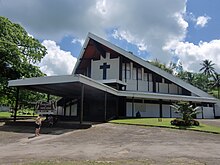
The population is around 45,000; predominately Melanesian, with small Polynesian, Asian, Australian and European populations, mainly French and British.
Languages
[edit]Port Vila is home to many languages, reflecting the country's high linguistic diversity.
The day-to-day lingua franca in the capital city is Bislama. In addition, English and French are also widespread.
Among Vanuatu's 100 indigenous languages, many are spoken in the capital, as people from rural areas come to live in the city, either temporarily or permanently.
Religion
[edit]Christianity is the predominant religion across Vanuatu, followed by more than 90% of the population. The largest denomination is the Presbyterian Church in Vanuatu, followed by one third of the population. Roman Catholicism and the Church of Melanesia are also common, each about 15%. Cathédrale du Sacré-Cœur is a modern Roman Catholic cathedral in Port Vila. The seat of the Diocese of Port Vila,[11] the church is dedicated to the Sacred Heart of Jesus.[12] On October 5, 2020, The Church of Jesus Christ of Latter-Day Saints announced plans to construct a temple in the city, and the Baháʼí Faith community is also established in Port Vila.[13]
Culture and education
[edit]Highlights of the city
[edit]The capital of Vanuatu has various sights to offer. There are several memorials, e.g. opposite the Parliament where two traditional totem poles and a monument representing a pig's tusk can be seen. The Presbyterian Church of Port Vila is an impressive and sightworthy building opposite the Independence Park. A colourful wall painting can be seen on the administration building opposite the market hall. Another noteworthy wall painting is on the façade of the post office. The City Hall of Port Vila is an oblong and sightworthy building on a hill in the city centre.
Vanuatu Cultural Centre
[edit]The Vanuatu Cultural Centre, hosting the Vanuatu National Museum, is located at the Saralana Park in front of the national parliament, close to the National Library and the Malvatumauri (Vanuatu National Council of Chiefs). This institution is an important place for the preservation and promotion of the different aspects of the local culture. Traditional artifacts from several islands are on display in the museum. The centre host also the National Audiovisual Archives which is the most important fund of documents from the late 19th century until today.
World Heritage
[edit]Port Vila was the location in August 1999 for the "2nd World Heritage Global Strategy Meeting for the Pacific Islands Region" held by UNESCO. One of the major topics related to Vanuatu and the Pacific region was the question of the suitability of underwater heritage for inscription on the World Heritage List.[14]
Education
[edit]This section needs expansion. You can help by adding to it. (May 2015) |
Port Vila is one location of the University of the South Pacific, an educational institution co-owned by twelve Pacific countries. The Vanuatu campus is the only law school in the university, and it also teaches languages.
Upper secondary (sixth form/senior high school) institutions include:
- Port Vila International School
- Central Secondary School
- Epauto Adventist Senior Secondary School
- Lycee de Montmartre
- Lycée Français J. M. G. Le Clézio (French international school)
- Malapoa College (Formerly known as British Secondary School)
- Onesua Presbyterian College
- NTCU Port Vila Christian College
Junior secondary (seventh form to tenth form) institutions include:
- Port Vila International School
- Central Secondary School
- Malapoa College (Formerly known as British Secondary School)
- NTCU Port Vila Christian College
- Seaside Community Secondary School
- Sorovanga Self-Support Community School
- Suango Mele Junior Secondary School
- Ulei Junior Secondary School
- Vila North Secondary School
Institutions
[edit]Municipality
[edit]The municipality of Port Vila is divided into four wards and administered by a council consisting of 14 members. The four wards are:
- Malapoa-Tagabe: Western and far northern neighborhoods
- Anabrou-Melcofe-Tassiriki: Northern and eastern neighborhoods
- Centre: Nambawan and Seaside neighborhoods
- South: Nambatu, Nambatri, and Elluk neighborhoods
Malapoa-Tagabe and South are allotted three representatives each to the council while Anabrou-Melcofe-Tassiriki and Centre have four.[15]
The municipality handles primary education, primary health care, regional planning, road maintenance and construction, trash collection, cemeteries, parks and open spaces and the promotion of tourism.
There are also informal settlements such as Blacksands which are effectively suburbs of Vila but are outside the municipality. Living conditions in some of these neighbourhoods are very poor, and lack of service provision and insecure land tenure are major problems.[16] Blacksands was squatted in the 1960s.[17]
The most recent municipal council election was held in 2022.
Constituency
[edit]This section needs to be updated. (May 2015) |
Port Vila is one of the eighteen constituencies in Vanuatu, and elects six Members of Parliament. Following the 2016 general election, its representatives are:[18]
| Member | Party |
|---|---|
| Kenneth Natapei | Vanua'aku Pati |
| Alatoi Ishmael Kalsakau | Union of Moderate Parties |
| Jean Pierre Nirua | Independent |
| Kalo Seule | Green Confederation |
| Ephraim Kalsakau | Independent |
| Ulrich Sumptoh | Union of Moderate Parties |
Twin towns – sister cities
[edit]Port Vila is twinned with:
References
[edit]- ^ "2020 National Population and Housing Census - Basic Tables Report, Volume 1, Version 2" (PDF). vnso.gov.vu. Vanuatu National Statistics Office. 17 November 2021. Retrieved 5 September 2023.
- ^ "2020 National Population and Housing Census - Basic Tables Report, Volume 1, Version 2" (PDF). vnso.gov.vu. Vanuatu National Statistics Office. 17 November 2021. Retrieved 5 September 2023.
- ^ Roberts, Anita. "First female Mayor urges respect for PVCC". Daily Post. Retrieved 9 August 2024.
- ^ Andrew Freedman (13 March 2015). "Monstrous Category 5 cyclone makes direct hit on tiny Vanuatu". Mashable. Archived from the original on 12 July 2019. Retrieved 4 April 2015.
- ^ "Wee, Small Republics: A Few Examples of Popular Government," Hawaiian Gazette, 1 Nov 1895, p. 1
- ^ "Climatologie" by Pierre Estienne and Alain Godard, Éditions Armand Colin (ISBN 2-200-31042-0), "CHAPITRE XVI 1. Les climats équatoriaux et subéquatoriaux 2. Les climats tropicaux 3. Les climats d'alizé 4. Les climats de montagne LES CLIMATS DE LA ZONE INTERTROPICALE : LES VARIÉTÉS", pages 314, 315 and 322.
- ^ "Klimatafel von Vila (Int. Flugh.) / Insel Efaté / Vanuatu (Neue Hebriden)" (PDF). Baseline climate means (1961-1990) from stations all over the world (in German). Deutscher Wetterdienst. March 2014. Archived from the original (PDF) on 10 May 2017. Retrieved 22 November 2016.
- ^ "Climate & Weather Averages at Bauerfield Efate weather station (91557)". Time and Date. Archived from the original on 6 February 2022. Retrieved 6 February 2022.
- ^ "Contact Us Archived 15 December 2016 at the Wayback Machine." Air Vanuatu. Retrieved 22 June 2010.
- ^ "International tourism, number of arrivals - Vanuatu | Data". data.worldbank.org. Archived from the original on 25 July 2021. Retrieved 25 July 2021.
- ^ "Cathédrale du Sacré-Coeur". GCatholic.org. Archived from the original on 4 February 2014. Retrieved 9 May 2013.
- ^ Les Missions catholiques (in French). 1938. p. 294.
- ^ "Baháʼí Community of Vanuatu". bahai.org. Archived from the original on 22 January 2021. Retrieved 26 April 2021.
- ^ "Second World Heritage Global Strategy Meeting for the Pacific, Port Vila (Vanuatu) 24-27 August 1999". Archived from the original on 19 December 2019. Retrieved 26 December 2019.
- ^ "1. Composition of Port Vila Municipal Council". Archived from the original on 9 January 2015. Retrieved 27 January 2019.
- ^ "Archived copy" (PDF). Archived from the original (PDF) on 4 March 2016. Retrieved 10 September 2015.
{{cite web}}: CS1 maint: archived copy as title (link) - ^ Hill, David; Chung, Margaret (2020). "Urban informal settlements in Vanuatu: Challenge for equitable development" (PDF). Report prepared for Pacific Islands Forum Secretariat and UN Economic and Social Commission for Asia and the Pacific, Pacific Operation Centre. Archived (PDF) from the original on 19 April 2021. Retrieved 16 March 2021.
- ^ "Members of the 11th Legislature of Parliament" Archived 29 November 2018 at the Wayback Machine, Parliament of Vanuatu
- ^ "Sister cities between Borabora and Port Vila". Daily Post. 11 May 2019. Archived from the original on 20 July 2020. Retrieved 20 July 2020.
- ^ a b "New Caledonia Enhances Ties With Vanuatu Capital City". pireport.org. Pacific Islands Report. 13 March 2017. Archived from the original on 20 July 2020. Retrieved 20 July 2020.
- ^ "Foshan doctors here to treat children". sista.com.vu. Sista. 10 January 2020. Archived from the original on 20 July 2020. Retrieved 20 July 2020.
- ^ "Mayor Sumptoh to renew 22-year-old relations with Shanghai". Daily Post. 15 October 2016. Archived from the original on 20 July 2020. Retrieved 20 July 2020.
- ^ "银川市友好城市及交流合作情况". yinchuan.gov.cn (in Chinese). Yinchuan. Archived from the original on 16 June 2022. Retrieved 20 July 2020.
External links
[edit] Media related to Port Vila at Wikimedia Commons
Media related to Port Vila at Wikimedia Commons
 KSF
KSF